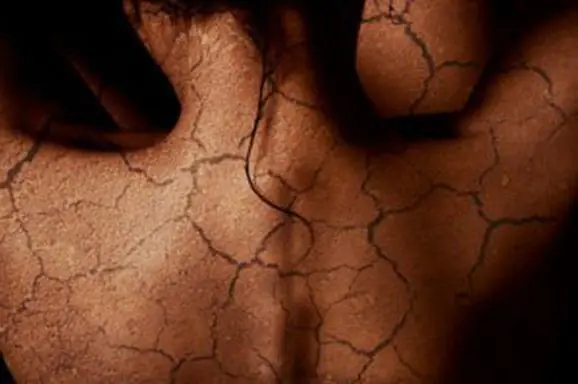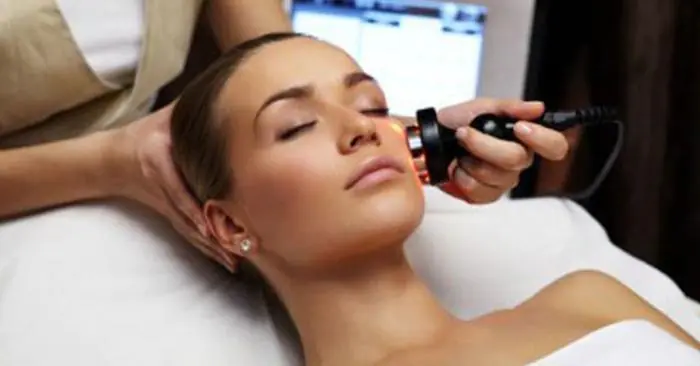Problems with the skin can cause a lot of trouble and discomfort. Peeling skin is one of the most common troubles encountered by many women, and sometimes men. Having found out the true reasons for what is happening, you can choose the right effective method to eliminate this cosmetic defect.
Why does my skin peel?
It has been found that dry skin flakes more often than other types. This is due to an insufficient supply of natural moisturizers - oily substances that are produced by the sebaceous glands.

Peeling scales and a feeling of tight skin can be caused by the following reasons:
- Incorrectly selected products for cosmetic care and cleansing of the face and body.
- Allergic reaction to washing powder, fabric softener, dishwashing detergent, cosmetics.
- Taking baths or showers too often.
- Climatic conditions (high air temperature, wind, direct sunlight).
- Dry air in winter.
- Bad habits.
- Insufficient fluid intake.
- Consequences of taking medications.
- Dermatological diseases.
Men also often experience peeling skin on their body or face. The reason for this may be alcohol abuse, smoking addiction and poor diet. Sensitive skin types react to mechanical stress with the appearance of redness and the formation of scales, so rubbing and using harsh cleansers is not recommended.
Is peeling a sign of illness?
This symptom may indicate a developing skin disease. One of these ailments is psoriasis, the spots in which have a pink-red tint, are flaky and itchy. The reasons that trigger the process are currently unknown. The same symptoms include seborrheic and contact dermatitis, pityriasis rosea, lupus erythematosus, scarlet fever (infectious pathology), and fungal infections. Hereditary diseases in which scales form on the skin include ichthyosis. The irritated surface of the dermis does not tolerate the effects of detergents (shampoo, soap, gel), and the unpleasant symptoms intensify.
With a lack of vitamins A and B2, the skin on the forehead, nose and ears peels off greatly, and cracks may appear on the lips. During menopause, many women experience a change in the condition of their outer skin for the worse. This is how the body shows a lack of hormones, especially estrogen. Wrinkles, sagging appear, and skin elasticity is lost. To find out the causes of peeling, you must seek medical help. Specialists in this field include a dermatologist, an allergist, an infectious disease specialist, and a surgeon.
First signs of dry skin
Characteristic signs of dry skin type are:
- Constant feeling of tight skin.
- Matte shade.
- Thin skin.
- Frequent occurrence of redness.
- Itching.
- Peeling.

If your facial skin is dry and flaky, you need to contact a cosmetologist who will select a suitable product to restore water balance. This type of skin is prone to the early appearance of wrinkles, which are not so easy to get rid of, and rapid aging.
Dry skin (xeroderma) can be associated with metabolic disorders in the body and diseases of the thyroid gland. Dead particles, accumulating on the surface of the epidermis, begin to peel off. Dermatitis can cause itching, so first of all you should consult a dermatologist.
In severe cases, very dry skin begins to crack and ulcers appear. This is fraught with infectious contamination.
Peeling skin: treatment
Having found the root cause of xeroderma, you can begin to eliminate the symptoms. If the problem is insufficient hydration or rapid evaporation of moisture from the surface, it is necessary to select cosmetics with a high content of fatty components. Medications are used only on the recommendation of a doctor. Such products should contain hydrocortisone (0.5–2%) in the composition.
If the skin on the body is peeling, you need to change the gel and soap. They can give this effect in the first place. It is better to wash your face with clean water or a decoction of medicinal herbs. Cleansing lotions and tonics should not contain alcohol, which causes dryness and tightens the skin.
Proper care for dry skin
Cosmetologists recommend that people with dry skin take water treatments no more than 2 times a day. This will help the sebaceous glands work properly and produce the required amount of natural moisturizing substances. Dry skin “loves” slightly warm or cool water, but never hot. After washing, you need to gently blot the surface of the dermis with a soft towel. Rubbing will cause redness and irritation of the skin.

After taking a shower, always use moisturizing milk or cream. For very dry skin, you can try cocoa or coconut butter. Thanks to the components they contain, the epidermis receives nutrients, minerals and vitamins. All kinds of peelings, face and body scrubs should be used no more than once a week so as not to injure dry skin.
What can a cosmetologist offer?
Beauty salons offer the following procedures to eliminate dry skin:
- Biorevitalization – is currently the most popular way to saturate the skin with moisture. Using various techniques (reinforcement, micropapule), hyaluronic acid is introduced, which will start the process of natural collagen formation. The framework, created from hyaluronic acid, collagen and elastin, will retain moisture and help smooth out deep wrinkles.
- Iontophoresis – if dry skin is flaking, then this method can restore water balance and relieve discomfort. The procedure involves treating the skin on which the drug is applied with a low-voltage galvanic current. Active ions transmit a signal to the central nervous system, and the body begins to renew itself.
- Mesotherapy – carried out for various indications: acne, dehydrated skin, wrinkles, rosacea, etc. The drugs are administered by injection and needle-free method (pulse iontophoresis). The goal of the procedure is to increase the activity of fibroblasts. These cells are responsible for the production of elastin and collagen.

Salon procedures can only be performed by specialists with appropriate education (cosmetologists, dermatologists).
How to choose a moisturizer?
Very dry skin on the face and body needs constant and proper care with moisturizing cream, lotion, milk, and tonic. This will help protect the thin epidermis from adverse environmental influences - strong wind, cold air, ultraviolet radiation. Particular attention should be paid to the skin of the hands and face.
Oil-based products perfectly eliminate moisture deficiency. Grape seed oil, almond oil, and shea butter are applied to the face. For washing, it is advisable to use milk, for example, Lait Demaquillant Absolu (Vichy), Natura Siberica. Problem areas on the body where there is flaky skin can be lubricated with olive oil.
Among cosmetic preparations, it is better to give preference to brands that are presented in pharmacies: Vichy (Lipidiose Nutritive), Bioderma (Atoderm). Natural ingredients and proven action through research will help restore freshness, firmness and elasticity to the skin. The disadvantage of such products is their cost, which is much higher than those available in cosmetic stores. When buying a moisturizer, you need to pay attention to the ingredients. The one that contains hyaluronic acid and vitamin E is better suited for the skin. The price will depend on the manufacturer and the naturalness of the ingredients. Sometimes the product may be chosen incorrectly, so it is better to seek advice from a professional cosmetologist or dermatologist.
Facial skin is peeling: what to do at home?
At home, it is quite possible to prepare products that will moisturize dry skin no worse than expensive ready-made preparations. The advantages of folk recipes include the availability of the necessary ingredients, natural origin and confidence in the naturalness of the product.

The most popular homemade skin care products are masks. After the first use, the result will be visible if you take oatmeal (1 tablespoon) steamed with milk and add a spoonful of homemade cream to it. There are also options with honey, butter, and full-fat cottage cheese (with added milk).
A mask with tocopherol (vitamin E) is suitable for dry skin. The price of the solution in the pharmacy is 35-45 rubles. (for 20 ml). Melt cocoa butter (1 tbsp) in a water bath, add 1 tbsp. l. liquid vitamin E and the same amount of sea buckthorn fruit oil. Tocopherol also combines well with lanolin (1:2). The masks are kept on the face for no more than half an hour, after which they are washed off with warm water or using a damp sponge.
Flaky skin? Homemade cream to the rescue!
Vitamin E Recipe
- Brew chamomile (1 tbsp) with boiling water, leave and strain.
- Add half a teaspoon of glycerin to 2 tbsp. l. chamomile decoction.
- Combine the resulting mixture with camphor and castor oil (1 tsp each).
- Finally, add 10 drops of tocopherol solution.
This cream can be stored in the refrigerator for up to 5 days.

Recipe for deep hydration
- Mix the pulp of healing aloe (2 tbsp) with glycerin (0.5 tsp).
- Add a few drops of olive oil.
- Dilute the resulting composition with any essential oil (no more than 7 drops).
Beeswax Recipe
- Coconut oil (3 tbsp) is mixed with clean water (3 tbsp) and a teaspoon of almond oil.
- Beeswax (1 tsp) is melted in a water bath and mixed with the previous components.
- Then add olive oil (2 tablespoons) and half a spoon of borax. During cooking, the ingredients must be stirred constantly.
Nutrition and diet
Peeling skin indicates a lack of useful microelements, vitamins and fluids, which enter the body primarily with food. Therefore, your diet should contain as many healthy foods as possible. Vitamins E, A and B necessary for the epidermis are found in various vegetables and fruits. But you will have to give up fatty meats, lard, smoked meats, canned food, and fatty fermented milk products. In general, it is better to consume meat in minimal quantities, including chicken.

If your facial skin is dry and flaky, it may be lacking vitamin A. In this case, you need to increase the amount of carrots, apricots (dried apricots) and green vegetables in your daily diet. Natural vitamin E is found in nuts, liver, seeds, eggs (they can cause allergies, so you shouldn’t lean on them). A hypoallergenic diet should be followed if the cause of dryness, itching and flaking of the skin is a disease.
Prevention of dry skin of the face and body
By following some tips and recommendations, you can quickly get rid of problems with dry skin:
- Try to shower no more than 2 times a day.
- Replace soap with cream-based gel.
- Body moisturizers are best applied to damp, clean skin.
- Use a barrier cream if flaky skin appears in winter.
- During the heating season, it is necessary to humidify the air in the house using special devices.
- On hot, sunny days, apply cream with ultraviolet protection to the face.

Many people have had to deal with such an unpleasant phenomenon as peeling skin. Red spots, unpleasant itching, dry crusts - all these symptoms often go along with skin irritation, which causes a lot of trouble and anxiety. How to deal with this problem and how to avoid it?
Causes of peeling skin on the body
There are many reasons why the skin can peel, we will highlight the most basic and common ones:
- Climatic conditions
Temperature changes, dry air, hot sun and frost - all this negatively affects the epidermis and causes various skin reactions. Winter and summer are often the most difficult periods for our skin. In winter, the skin is overdried due to dry air from radiators, wearing a lot of clothes and hot water. In summer, our skin is exposed to the sun, wind and water, which also leads to dehydration. Extra hydration and proper skin care will help you prevent skin flaking during such periods. - Allergic reaction
Often, peeling of the skin is an allergic reaction to some pathogen. Here we can talk about both the use of cosmetics that cause such consequences, and an incorrect diet. Before applying new cosmetics, it is best to test them on separate areas of the skin. Body products can be applied to the crook of your elbow and see if there is an allergic reaction; creams and face masks can be applied to your ears to make sure they suit you. Speaking about an unbalanced diet, it should be noted that the skin peels off after alcohol, especially in the face area. The thing is that alcohol greatly dehydrates the skin, so it is important to monitor the consumption of strong drinks.
Very often, household chemicals also cause such a skin reaction, so try to minimize skin contact with various chemicals and be sure to use rubber gloves. - Mechanical skin damage
Mechanical damage to the skin should not be written off either. This includes wearing clothes made of rough or synthetic materials, hard bath towels and improper care. Frequent cleansing procedures using scrubbing particles can severely damage the skin and cause peeling. It is important not to overdo it with the washcloth. You can often hear complaints that the skin is peeling after sugaring. Unfortunately, during this procedure, invisible mechanical damage to the skin occurs, which can lead to various skin reactions. Those with sensitive skin should avoid such procedures. - Improper hygiene
Excessive use of detergents also harms the skin. When caring for your face, you should avoid using soap. This applies not only to the face, but also to the décolleté area, which is very sensitive. There is no need to wash your body with shower gel or soap every day, the only exceptions being the armpits, feet and intimate areas. If you like to soak in a hot bath or stand in the shower, then remember that it is better to take such water procedures for no more than 20 minutes, otherwise the risk of drying out the skin is extremely high. It is important to choose the right cleaning products. It is not recommended to overuse soaps, gels and other products with antibacterial properties; they dry the skin too much. - Non-compliance with drinking regime
Almost everyone knows that a person should drink at least 1.2-2 liters of clean water per day, but not everyone follows this recommendation and does not know what consequences may arise due to non-compliance with the drinking regime. One of the frequent and widespread manifestations of a lack of fluid is dry skin and, as a result, the appearance of peeling. It is extremely important to maintain a drinking balance and monitor the amount of water you drink.

What do itching and redness of the skin on the body indicate?
Very often, in addition to dry skin, itching or redness also appears. In most cases, only a doctor can give an accurate answer after examination and tests. But in general, there are a number of reasons that most often contribute to the appearance of these symptoms:
- Stress. Redness of the skin and itching can appear during times of strong emotions and excitement. This is a normal reaction of the body and there is no need to worry.
- Bites and damage. Sensitive skin reacts extremely sharply to any irritants, so even rough clothing can cause redness and itching.
- Hypersensitivity of skin vessels. Redness may appear when the temperature changes. Thus, in hot weather and hypothermia, the skin often turns red.
- Various diseases. Such symptoms can appear in diseases of the endocrine system, autoimmune diseases, and cardiovascular diseases.
Skin diseases with peeling skin
Often such unpleasant symptoms can be a sign of a skin disease. In this case, it is best to consult a doctor immediately so as not to progress the disease.
Dermatitis
The main cause of peeling is dermatitis. There are atopic, allergic and seborrheic dermatitis. Atopic dermatitis is accompanied by itching and redness, and here it is extremely important to follow an integrated approach, which includes not only the use of the right pharmaceutical and cosmetic products, but also proper nutrition and cleansing of the body. Allergic dermatitis is often a reaction to a food or contact irritant. This reaction lasts for about a day and appears only in certain areas of the body. Seborrheic dermatitis is accompanied by the active development of fungus in the epidermis and occurs quite often in people with oily skin.
Dermatoses
There are many types of this disease, but the most common are eczema and neurodermatitis. Some symptoms can last a lifetime, while others are temporary. It is important to remember that this problem cannot be solved without medical participation.
Psoriasis
This disease is one of the most severe, and treatment may not bring any results. The exact causes of psoriasis are difficult to establish, but many doctors agree that this disease often manifests itself after severe stress.
Peeling skin after sunbathing
This unpleasant reaction to the sun is familiar to many. This is mainly a consequence of lack of skin hydration. How to avoid this?
- Be sure to use sunscreen.
- After sunbathing, you should moisturize your skin with any product.
- Be sure to follow the drinking regime. Under the sun, the skin quickly loses moisture and needs to be moisturized from the inside. Take water with you to the beach and don’t forget to drink it.
- Use a gentle exfoliating scrub. This will not harm your tan, but will gently remove excess skin flakes.
- Watch your diet. Your diet should include foods rich in omega 3 - olive oil, red fish, avocado.
Skin peels after shower
To avoid peeling skin after a shower, remember that too hot water dries out the skin. Make sure the water is at a moderate temperature and never use scrubs, exfoliators or shower lotions every day. If you use body oil, you should apply it not to dry, but to damp skin. This way the oil will be absorbed faster and better.

How to get rid of peeling skin: folk remedies
Milk baths
Taking milk baths is a great way to hydrate your skin. For such baths you will need 1.5-2 liters of milk. You should shave milk with a fat content of 3.2%, no less. Just warm the milk a little and add it to warm water. For greater effect, along with milk, you can also add the following ingredients to the bath:
- ground oatmeal. Oats perfectly nourish the skin and are a gentle exfoliant.
- honey. You will need about 80 grams of honey, heated in a water bath.
- herbal decoctions. Decoctions of chamomile, calendula, and sage are ideal.
You should take such baths at least 2 times a week for 15-20 minutes.
Masks with oils
To deeply moisturize the skin, it is good to make masks with various oils. Mix honey and any vegetable oil in equal proportions (olive, coconut, flaxseed are good) and apply to problem areas. Leave for 15-20 minutes, then rinse with warm water.
Glycerin mask
A mask with glycerin also combats dry skin well. Mix glycerin, honey and heavy cream in equal proportions. Add crushed oat flakes to the resulting mass until a homogeneous thick mass is obtained. Apply to skin for 20 minutes.
Remedies for peeling skin
There are a number of pharmaceutical products that can help prevent or get rid of this problem.
Bepanten. Remedy No. 1 in the fight against dry skin. Ideal for both adults and children.
Sudocrem. Copes well with various eczema and skin damage.
Dexpanthenol. Prescribed for various types of dermatitis. Heals the skin and removes cracks.
Hormonal medications are also used to treat peeling, but this should be done as prescribed by a doctor. The most common drugs: Hydrocortisone, Betamethasone, Metrogyl.
Peeling skin: what vitamins to take
- Omega 3
Omega 3 amino acids will help eliminate skin problems. They are an important component in the treatment of various dermatitis. Taking these amino acids saturates and nourishes the skin, helps cope with dryness and aging. - Vitamin A
Moisturizes the skin, makes it more elastic. - Vitamin B2
This vitamin is prescribed along with other medications in the treatment of dermatoses. If you have rough and unhealthy-looking skin, then it is quite possible that your body is deficient in riboflavin. - Vitamin E
Combats dry skin, eliminates redness. - Vitamin PP
Makes the skin smooth and helps get rid of flaking.
If you decide to seriously deal with skin problems, then do not forget that only an integrated approach will help you get rid of peeling. Regular and proper skin care, a balanced diet, taking vitamins - all this will definitely bring results. Be sure to follow our tips and share your results!

December 25, 2013
Peeling of the skin of the body and face is a problem that a person may encounter throughout his life due to the development of various diseases, as well as due to the influence of certain factors.
Why does skin peeling occur?
Severe peeling of the skin occurs periodically in many people. Itching and flaking of the skin bothers a person who has an excess layer of dead epidermis on the surface of the skin. This occurs in the process of too much rejection or keratinization.
If a person experiences peeling of the skin, he often feels moderate or severe itching and discomfort. Dry skin is noted. Peeling of the skin can have varying degrees of severity. This can be either a change in the skin that is almost invisible to the naked eye, or a pronounced change, as a result of which the skin becomes like bran. If such pathological processes last for years, then periodically they may fade and then appear again.
In medicine it is determined natural (physiological) And pathological skin rejection. Physiological processes of skin cell rejection occur due to the regeneration of the epidermis. The vital activity of the human body occurs in such a way that approximately once a month (every 26-28 days) the upper layer of the skin is completely renewed.
Pathological skin rejection occurs under the influence of a certain unfavorable factor or a combination of them.
The cause of peeling of the skin determines how long and intensively this process will occur, and where exactly the peeling will appear. Sometimes the skin peels off for one or two days. But with some diseases, peeling of the epidermis can continue even for decades.
In some cases, the question of how to get rid of flaking skin becomes irrelevant after using moisturizing or nourishing products. A properly selected mask against peeling skin is often effective. But if there is not only dryness and flaking of the skin, but there are also other symptoms that bother a person, it is necessary to consult a specialist.
Peeling skin can occur at any age, in both men and women.
Peeling of the skin is often observed in newborns. Infants typically experience dry and flaky scalp and face.
Why is skin peeling?

Dryness and severe flaking of the skin of the face and scalp is a common problem not only among people who have naturally dry skin. Often the reason why a person experiences peeling skin on the face is an incorrect water-fat balance in the upper layer of the skin. Very often, people who experience redness and flaking of their facial skin use the wrong care products. For example, if oily facial skin is flaking, a person uses an alcohol-based de-flaking product. As a result, the skin condition worsens even more. Someone who has dry facial skin does not always benefit from a nourishing or moisturizing cream against flaking facial skin. Therefore, it is best for masks, creams and other products to be recommended by a dermatologist after determining the cause of peeling skin.
Peeling of the skin can occur in the body due to problems in the functioning of the gastrointestinal tract. Problems with the skin can also arise due to a lack of certain vitamins in the human body. So, if there is a deficiency vitamin B12, then the skin may begin to peel on the ears, on the nose, and peeling of the skin of the eyebrows is also noted. Peeling of the skin between the eyebrows and under the eyebrows also occurs due to seborrheic dermatitis. This disease often manifests itself against the background of metabolic disorders, improper care of the skin of the face and head, etc.
Peeling of the skin also occurs as a result of experienced stress, that is, due to nervous overstrain. Often this symptom is associated with allergic reactions. If a person experiences such a reaction, it is important to determine the allergen that caused severe peeling of the skin. The cause of peeling skin on the human body may be a hereditary tendency to dry skin. Also, a factor that provokes peeling is often any damage to the skin - wounds, cracks, inflammation. Sometimes dry skin is a consequence of prolonged treatment with certain medications.
To keep your skin healthy and fresh, it is important to have the correct hormonal balance in the human body. Dry and flaky skin can be a consequence of a disruption in the production of sex hormones, as well as thyroid hormones. That is why peeling skin is often a symptom that accompanies a woman during the menstrual break.
When listing the reasons that influence the appearance of skin peeling, we should note the impact of some external factors. We are talking about wind, sunlight, extreme cold. In addition, during the cold season, indoor air is usually dried out due to heating.

Dryness and severe peeling of the skin of the hands and feet in people with sensitive skin is due to the fact that every day the skin on the hands and feet of a person comes into contact with water, household products, cosmetics, and is also subjected to mechanical stress. However, often the causes of flaking of the skin of the hands are associated not only with the influence of external factors. The skin on the palms of the hands and between the fingers sometimes peels off due to infection with fungal infections, parasites or pathogenic microorganisms. Peeling skin on the hands is often associated with the development dermatoses. In case of illness psoriasis, red ringworm and other skin diseases, peeling of the skin on the elbows, peeling of the skin on the palms, etc. are also noted. Allergic manifestations should be highlighted as a common cause of peeling of the skin of the palms and fingers. In addition, peeling of the skin on the fingers in some cases is a consequence vitamin deficiency, lack of a number of microelements in the body, dehydration.
Only a dermatologist can determine the exact cause that explains the manifestation of peeling of the skin of the hands and feet, after conducting a comprehensive examination of the patient.
Redness and peeling of the skin of the legs very often develops under the influence of external causes, when eliminated, the condition of the skin gradually returns to normal. For example, if a person wears tight clothes that do not provide normal air circulation, the skin may begin to peel between the legs, on the thighs, and ankles. Incorrectly selected and poor-quality shoes often provoke flaking of the skin of the feet, dryness and flaking of the skin on the toes. If peeling is observed between the toes and on the soles of the feet, then fungal diseases should be excluded.
If you have the slightest suspicion that peeling skin on the legs is associated with infections, purulent diseases, or allergic reactions, you should definitely consult a doctor, since the elimination of external signs does not always indicate a cure for the underlying disease.
Another problem that both men and women may experience is redness and flaking of the eyelid skin. If peeling of the skin around the eyes occurs, the first thing to do is to rule out allergies to cosmetics, hygiene products, or food. Peeling of the skin of the upper eyelid and lower eyelid can be caused by a parasite - eyelash mite. In case of illness demodicosis Not only does a person’s skin peel off, but eyelashes also fall out. The skin of the eyelids may also peel due to exposure to a number of external factors described above.
Very often, severe redness and flaking of the scalp in a baby worries a young mother. But in most cases, this phenomenon is quite natural, since the child’s skin does not have the necessary protective barrier, and irritating factors from the outside can cause such a reaction. The reasons why a baby develops itching and flaking of the scalp may be due to improper care, mechanical irritation, and allergic reactions. Your pediatrician will tell you how to get rid of allergies and how to treat such manifestations. But sometimes treatment for peeling skin is not necessary. All you need to do is change clothes, bathe your baby properly, comb out dead skin particles, and use properly selected skin care products.
Sometimes peeling skin in babies can be associated with symptoms ichthyosis. This disease should be treated only under the constant supervision of a specialist.
How to get rid of peeling skin?

When peeling the skin of the face and other areas of the body, it is recommended to regularly use creams and other products that have a moisturizing effect. Such cosmetics must have a fatty base, which is a kind of barrier and does not allow moisture from the epidermis to seep out.
However, after using cosmetics, the desired effect is not always observed. But if peeling on the face and other parts of the body occurs due to the development of diseases, it is better not to practice independent treatment in this case. You have to fight peeling skin with the help of a variety of medications prescribed by your doctor. If peeling skin is a symptom of a disease that the doctor diagnosed during the examination, then comprehensive treatment is carried out to eliminate the underlying disease.
Peeling areas on the face can be treated with a cream that contains hydrocortisone. This procedure should be carried out for one to two weeks, while facial treatment is carried out once a day.
Peeling skin on the hands is eliminated by using aquaphoror – a cream that contains hydrocortisone. The cream is applied in a thick layer to your hands, after which rubber gloves are put on. The cream should be applied in this way at night.
In some cases, treatment of skin peeling is carried out using drugs with dexapanthenol. It is also possible to carry out a number of procedures that are not aimed at restoring the normal condition of the skin. This is mesotherapy, peeling, biorevitalization. The specialist prescribes the procedure depending on the cause of the disease.
Home procedures for moisturizing facial skin will be advisable if peeling of the skin is caused by external factors. In this case, when your facial skin is peeling, it is better not to use soap to wash your face and not to wipe your face dry with a towel. Be sure to use a high-quality moisturizer. Before going outside in winter, you should apply a protective cream to your skin. It is important to ensure sufficient air humidification in the room in which a person constantly resides.
At home, you can practice using masks to moisturize your skin. The skin should first be prepared for applying the mask using a scrub. Suitable scrubs include coffee grounds, green apple pieces, and tea leaves. Masks for moisturizing the skin can be prepared from vegetable oils. For this purpose, wheat germ, almond, grape, and peach seed oils are mixed in equal proportions with honey.
The mask can also be prepared from a mixture of sour cream or cream with cucumber pulp. These masks should be applied to 20-30 minutes.
To prevent peeling of the skin of a newborn, it is important to purchase a special product for bathing babies, since regular soap dries out the baby’s delicate skin.
You should not bathe your baby too often, and after taking a bath, you should apply a baby moisturizer to your baby's skin. Some babies have an allergic reaction to products with lanolin, so it is better to avoid such creams and shampoos. The air in the room where a small child lives must be humidified. It is especially important to do this during the heating season.
A nursing mother should carefully monitor her own diet, because some foods can cause allergic reactions in the child, which are expressed by peeling skin and other manifestations.



